
Related
Guests
- Narges Bajoghliprofessor of Middle East studies at Johns Hopkins University and the author of Iran Reframed: Anxieties of Power in the Islamic Republic.
Fallout continues to mount following the U.S. assassination of Iran’s top military commander Qassem Soleimani in Baghdad last week. Iranian media reports that over a million mourners took to the streets of Tehran today for the funeral of Soleimani, who headed Iran’s elite Quds Force. On Sunday, Iran announced it would suspend its commitments under the landmark 2015 nuclear deal, which the U.S. pulled out of in 2018. Trump has also threatened to target 52 locations in Iran, including cultural sites, if Iran retaliates against the U.S. The targeting of cultural sites is widely viewed as an international war crime. Meanwhile, Iraq’s caretaker Prime Minister Adel Abdul-Mahdi has revealed he had plans to meet with Soleimani on the day he was killed to discuss a Saudi proposal to defuse tension in the region. From Washington, D.C., we speak with Narges Bajoghli, professor of Middle East studies at Johns Hopkins University and the author of “Iran Reframed: Anxieties of Power in the Islamic Republic.”
Transcript
AMY GOODMAN: Fallout continues to mount following the U.S. assassination of Iran’s top military commander, Qassem Soleimani, at the Baghdad airport on Friday morning. Iranian media is reporting over a million mourners took to the streets of Tehran today for the funeral of Soleimani, who headed Iran’s elite Quds Force. On Sunday, Iran announced it would suspend its commitments under the landmark 2015 nuclear deal, which the U.S. pulled out of in 2018.
The Iraqi Parliament voted Sunday to expel all U.S. military forces from Iraq. President Trump responded by threatening to impose sanctions on Iraq, quote, “like they’ve never seen before.” Iraq has already been the target of some of the harshest sanctions the world has even seen. U.S.-backed sanctions killed more than a million Iraqis, including more than half a million children, between 1990 and 2003.
Trump has also threatened to target 52 locations in Iran, including cultural sites, if Iran retaliates against the U.S. The targeting of cultural sites is widely viewed as a war crime. Trump said the number 52 was for Iran’s taking of 52 U.S. hostages 40 years ago.
Meanwhile, more information has come to light about the timing of Soleimani’s assassination. Iraq’s caretaker Prime Minister Adel Abdul-Mahdi has revealed he had plans to meet with Soleimani on the day he was killed to discuss a Saudi proposal to defuse tension in the region. Mahdi said, quote, “He came to deliver me a message from Iran, responding to the message we delivered from Saudi Arabia to Iran.”
This comes as the U.S. continues to increase its presence in the Middle East. The U.S. is sending nearly 3,000 more troops from Fort Bragg to the region. Meanwhile, the U.S. has announced it’s temporarily halting its fight against ISIS in Iraq and Syria so it can redirect it focus in the region.
We begin today’s show with Narges Bajoghli, professor of Middle East studies at Johns Hopkins University. Her recent opinion piece for The New York Times is headlined “Suleimani’s Death Changes Nothing for Iran.” She is the author of Iran Reframed: Anxieties of Power in the Islamic Republic. And in Baghdad, Ghaith Abdul-Ahad, correspondent for The Guardian newspaper, is back with us. His latest piece is headlined “Iran ends nuclear deal commitments as fallout from Suleimani killing spreads.”
Let’s begin with Professor Bajoghli. Right now the reports of up to a million people are in the streets of Tehran. The body of Soleimani has been returned, and the funeral is underway. Can you talk about the significance of the assassination and what has happened since?
NARGES BAJOGHLI: Yes. I mean, a week ago, it would have been unthinkable to have crowds like this in Iran. Today was Tehran; yesterday in Ahvaz and Mashhad; tomorrow the body will go on to Kerman. After the violent crackdown that the state orchestrated against protesters in November of 2019 — so just a month and a half ago — there was so much anger in Iran because of the violent crackdown of the state, that there really was another crisis of legitimacy within the Islamic republic in dealing with the fallout of the maximum-pressure campaign and the severe sanctions that the Trump administration has put on them.
So, to think that these numbers of people are coming out onto the streets really signals two things. One, Qassem Soleimani, within Iran itself, was seen as a national hero, because he was seen as keeping ISIS at bay, and, two, because of Trump’s tweets just two nights ago that he would target Iranian cultural sites, it’s creating a sense of national unity within the country. And this is no longer about support for the regime, but it’s really about standing up to a foreign aggressor. This is something that — the killing of Soleimani, the assassination of Soleimani, and then Trump’s repeated tweets and threats, is doing two things: one, rallying Shia, sort of a transnational Shia community, especially those that are loyal to the Islamic republic in Iran, and then, two, rallying national sentiment within Iran against the United States.
AMY GOODMAN: I mean, this threatening to blow up Iranian cultural sites, I mean, it’s as if someone is threatening to blow up the Empire State Building or — well, on Saturday, Trump tweeted, “Iran has been nothing but problems for many years. Let this serve as a WARNING that if Iran strikes any Americans, or American assets, we have targeted 52 Iranian sites (representing the 52 American hostages taken by Iran many years ago), some at a very high level & important to Iran & the Iranian culture, and those targets, and Iran itself, WILL BE HIT VERY FAST AND VERY HARD. The USA wants no more threats!” Trump tweeted. So talk about this and him going back 40 years to say that’s how he chose that number, 52, and what this means to the Iranian people.
NARGES BAJOGHLI: Two things. One is that — you know, for me, what this signifies is the continued misunderstanding of United States and U.S. policymakers when it comes to Iran and the Iranian revolution and what it’s produced. I think because there’s been such an obsession in the U.S. after the — during and after the hostage crisis, in particular with understanding the Iranian revolution of 1979, as — like this obsession with it solely being an Islamic republic and an Islamic revolution, has meant that much of our analysis in this country and throughout the West, in particular, really undermines and does not think about the complexities within Iran and Iranian history.
The 1979 revolution itself, not thinking about what comes after it, was a revolution, a popular revolution, first and foremost. So this was not a revolution led by a vanguard or an elite. This is one of the most popular revolutions of the 20th century, a revolution led from below in which the main thrust of it and one of the main slogans of the revolution was “neither east nor west,” meaning neither the Soviet Union nor the United States. It really was a revolution that was about creating independence and sovereignty in Iran and not having it be under the sway of imperial powers. That is first and foremost. And that is a continuation of a centuries-long movement in Iran to establish independence within the country.
So, what happens after the revolution in Iran and the Islamic republic coming about, there are a lot of Iranians, both within the country and outside, obviously, who disagree with the Islamic republic. However, I think what’s important to understand — and this is where Trump, for all of the things that he has been doing on Iran, and I do think regime change and regime collapse is the policy of this administration when it comes to Iran — but the huge mistake that he made with that tweet the other night, by claiming to want to attack Iranian cultural heritage sites, is that he is now bringing up that sentiment again within the Iranian population, that as much as some within Iran may dislike the Islamic republic, they will not stand for a foreign aggression, especially from the sole superpower in the world, to come and attack their country and attack historical sites that have nothing to even do with the regime, but it’s about Iranian culture, which is thousands of years old.
AMY GOODMAN: Narges Bajoghli, tell us who Qassem Soleimani was.
NARGES BAJOGHLI: Qassem Soleimani was the major general of the Quds Forces of the Islamic Revolutionary Guard in Iran. The Quds Force is the main force of the Revolutionary Guard which is in charge of extraterritorial operations of the Revolutionary Guard, meaning operations outside of Iran.
Now, Soleimani himself, during the 1980s, was a veteran of the 1980-'88 war with Iraq, which was the longest conventional war of the 20th century. That is where he learned how to fight. That is where he began to learn and to develop his understanding of international politics. And one of the things I think it's important to remember is that the war of the 1980s, which was an extremely bloody war — it was one of the wars in which trench warfare was fought for the first time after World War I — this is a war in which, for all of the political and elites of the Islamic republic, and especially those who fought in the war, they began to understand their viewpoint of international politics in that time, in which they saw how the United States and Western powers were supporting and supplying Iraq with weapons and intelligence during that time. So he comes about in that battlefield and in those wars.
From that point on, he then goes on into the Quds Force. And what is important to understand here is that as important of a general as he was — and he was significant — he, nonetheless, within the Revolutionary Guard — one of the things that the Revolutionary Guard has become so adept at, because it sort of had to, is asymmetrical warfare. But what that means on the ground is that decision-making within the Revolutionary Guard — and I studied them for 10 years in Iran, and I saw this no matter what area that they were functioning in — decision-making power and leadership within the Revolutionary Guard is very much done in an ad hoc way. And that is a legacy of the 1980 wars — of the 1980s war. And so, Qassem Soleimani was in charge of the Revolutionary Guard’s relationship especially in the Middle East and with Iraqi and Lebanese forces, Shia forces, but he was not the only one who was able to create these relationships, nor was he the only one who was doing these strategic maneuverings within the region.
He rose to prominence as a public figure in around 2013, and part of the reason for that is that there was very large media — a very large media campaign created for Qassem Soleimani within Iran. I followed around his media teams for a few years and saw how they made documentaries about him, music videos, films. There’s fiction films about him now, made in Iran, and films and documentaries and music videos made in Arabic, as well, for Arab audiences. And the reason that they were doing that at the time was to shore up support for Iran’s fight against ISIS. Because of that, he becomes this really prominent public figure, which is something that we often don’t see within Iran. You know, in order to sort of understand Soleimani, you have to understand that this hero-like status that he began to have is not very common within the culture of the Islamic republic. They make heroes out of martyrs, but they don’t necessarily make heroes out of living figures. Qassem Soleimani, though, did become a hero because of this concerted media effort in order to rally up support for the fight against ISIS.
AMY GOODMAN: So talk about the significance of him being assassinated and what this means.
NARGES BAJOGHLI: So, one thing is very important to note. As many Iranians were protesting against the government in November and have been protesting against the government for decades now, there is a very large contingency within Iran that does not support the Islamic republic or wants significant reforms to the Islamic republic. However, Qassem Soleimani, because of the depictions of him within Iran, especially after 2013, and because of his role in fighting against ISIS in Iraq and Syria, he was really sort of seen as being above the fray of the internal politics of the Islamic republic, for two reasons. One is that his activities were focused outside of Iran and not inside of Iran, so that he therefore wasn’t sort of caught up in the fractious politics of the Islamic republic. And, two, he was not a corrupt person. So, within the Islamic — within the Revolutionary Guard in particular, there have been a lot of corruption scandals in Iran, with, you know, different folks embezzling money, especially when it comes to the sanctions and things like that. He sort of stayed above that. And if you see images from the supreme leader and the president and all these other dignitaries visiting his family home in Tehran over the past few days, you’ll be able to also see, very visually, that his home is very humble. So he really stayed above that. And for those reasons, he remained extremely popular within Iran.
Now, too, he’s also a very — he also had a very hero-like status outside of Iran, as well, among Shia armed groups and among certain Shia communities in Iraq and Lebanon, again, because of the way in which he helped to direct forces against the Islamic State, which one of their main goals and one of their — they said over and over again that they saw the Shia as their main enemy. And so, because of that, he was sort of seen as this main protector. Within Iran, for years, one of the main slogans that you would hear over and over again and that people would repeat was that if Tehran and Qassem Soleimani were not in Damascus, then Daesh, or ISIS, would be in Tehran. So, because of that, he really was an important national and symbolic figure.
Now, the importance of his assassination is that because he was seen as this really important military hero that kept the homeland safe and that worked against ISIS and ultimately U.S. forces in the region, this — and this is what I wrote in The New York Times piece — he is this — I mean, there is nobody that the Islamic — or, that the United States could have assassinated with a higher — you know, a symbol that was sort of higher than him, in a way, and that would have unified people in the way that it has. I mean, I don’t think that the Trump administration fully understands what it has done in this regard when it comes to Iran and Shia communities across the region. As a symbol, Qassem Soleimani will have and has proven in the past two days to be a symbol that will move people to action.
AMY GOODMAN: And then let’s talk about the nuclear deal. Speaking to CNN’s Jake Tapper Sunday, Secretary of State Mike Pompeo suggested that Obama’s landmark Iran nuclear deal was tantamount to starting a war. This is Pompeo referring to the JCPOA — that’s the Joint Comprehensive Plan of Action — which has been heralded by many as a major international diplomatic victory for peace.
SECRETARY OF STATE MIKE POMPEO: This war kicked off — people talk about the war. This war kicked off when the JCPOA was entered into. It told the Iranians that they had free rein to develop a Shia crescent that extended from Yemen to Iraq to Syria and into Lebanon, surrounding our ally Israel and threatening American lives, as well. We’ve taken a very different approach. That approach has been successful.
AMY GOODMAN: So, if you can respond to this, Professor Bajoghli, and also that Iran has just announced they, too, will no longer abide by the Iran nuclear deal? I mean, the U.S. pulled out of it in 2018, but Iran was resisting pulling out entirely, until now, until the number two man in Iran, Soleimani, was assassinated by Trump.
NARGES BAJOGHLI: Well, one thing I’m going to say real quick here is that actually Iran hasn’t pulled out of the JCPOA yet. The announcement that Iran made yesterday is actually within still the confines of the JCPOA, and they have stated clearly that if other parties come back to the JCPOA, they will also reverse the steps that they have taken. So they actually haven’t pulled out of the JCPOA. It’s a very strategic and, frankly, surprising move. I did expect them to pull out, but they haven’t. And so it shows that they’re actually being very strategic about the reactions that they are having to Soleimani’s death at this point.
Now, going to Pompeo’s statement, I mean, that statement just frankly doesn’t understand the U.S.'s role in the region, not only since 2003 with the invasion of Iraq, but longer than that. But going specifically to what he said about the JCPOA, the JCPOA itself, whatever critiques that folks on the right may have of it, it was — and this was something that the Obama administration said over and over again — an initial framework for engagement with Iran. Whether folks within the Trump administration like it or not, Iran is a country that has — or, the Iranian civilization is one that has been in the region for thousands of years. It is not going anywhere. It's one that, no matter how much they try to isolate, will not disappear.
So, by pushing it further into the corner, as the Trump administration has done with pulling out of the Iran nuclear deal and then imposing such harsh sanctions, and not only imposing sanctions, but also undertaking covert actions, doing cyberwarfare against Iran, what all of this has produced is a situation in which Iran feels completely cornered. And that is part of the reason why we saw Iran lash out the way that it did over the summer and the months — and a few months over the fall. So, the fact — I mean, the JCPOA was a framework in which the Obama administration, it seemed, was trying to slowly normalize ties with Iran in a way so that then they could then begin to talk about other issues that the U.S. or European powers may have had with Iran. It’s actually the Trump administration and the way that they pulled out of the deal and then have begun to apply this maximum-pressure policy against Iran that has, in effect, produced the conditions of war with Iran.
AMY GOODMAN: According to The Washington Post, Qassem Soleimani multiple times used memes on social media to mock President Trump. In July 2018, after Trump threatened the Iranian President Hassan Rouhani on Twitter, Soleimani responded by telling Iran’s Tasnim News Agency, “If you begin the war, we will end the war. You know that this war will destroy all that you possess,” he said. A few days later, Soleimani posted an edited image of himself standing with a walkie-talkie in front of an exploding White House onto Instagram. Text on the image read, “We will crush the U.S.A. under our feet.” In November of that same year, after Trump tweeted a Game of Thrones-inspired image of himself with the text “Sanctions are coming,” Soleimani posted his own Game of Thrones meme with an image of himself and text reading “I will stand against you.” In April of 2019, Twitter suspended Soleimani’s account. They haven’t suspended Trump’s account. Your response, as we wrap up?
NARGES BAJOGHLI: Yeah, I mean, look, Soleimani has had a very large media team around him. The Revolutionary Guard, and especially when it comes to the threats that the Trump administration has been making once it pulled out of the Iran deal — and I think one thing that’s really important to point out here is the role of John Bolton within the administration and him being very adamant for many, many years about regime change in Iran. So we were dealing and we have been dealing with an administration here in the United States which has had its eyes on weakening Iran to the point of either regime collapse or regime change.
So, Qassem Soleimani and the Revolutionary Guard and the media teams that the Revolutionary Guard have, which are extremely big, they receive a lot of state funding. The Revolutionary Guard itself has a lot of funding that it pours into its media production. I mean, that’s what I studied for so many years, and I was looking at all of these different media teams. They have been responding in this way. They will continue to respond in this way. This is also — again, remember, as much as the United States sort of tries to control the narrative, the public narrative, when it comes to Iran, within the West, Iran tries to control the public narrative especially among the internal population in Iran and among Arab Shia populations, as well. So we’ll continue to see these sorts of tit-for-tats, whether in narrative, in rhetoric or in memes of internet culture.
AMY GOODMAN: Narges Bajoghli, we want to thank you for being with us, professor of Middle East studies at Johns Hopkins University. We’ll link to your piece in The New York Times, “Suleimani’s Death Changes Nothing for Iran,” author of Iran Reframed: Anxieties of Power in the Islamic Republic, also director of The Skin That Burns, a documentary film about survivors of chemical warfare in Iran.
This is Democracy Now! When we come back, we go to Baghdad. Stay with us.

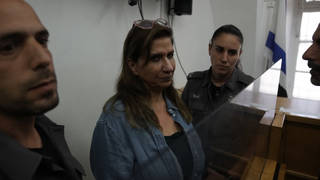
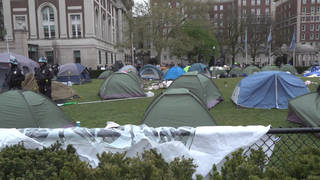
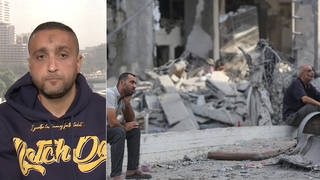
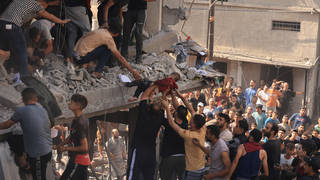





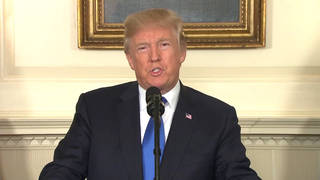

Media Options